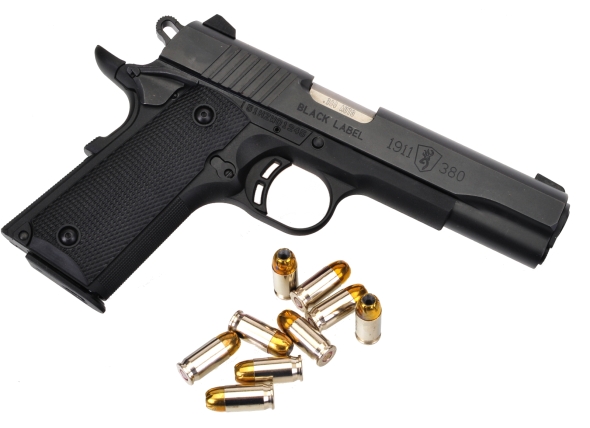
If you missed the “1911 380” emblazoned on the side of the slide in the picture above, you are probably thinking this is a 1911 type. It is… sort of. It is a Browning Black Label 1911-380 autoloader, a pistol that shares many attributes with the full size 1911, but it has been proportionally scaled to better suit the 380 Auto cartridge.
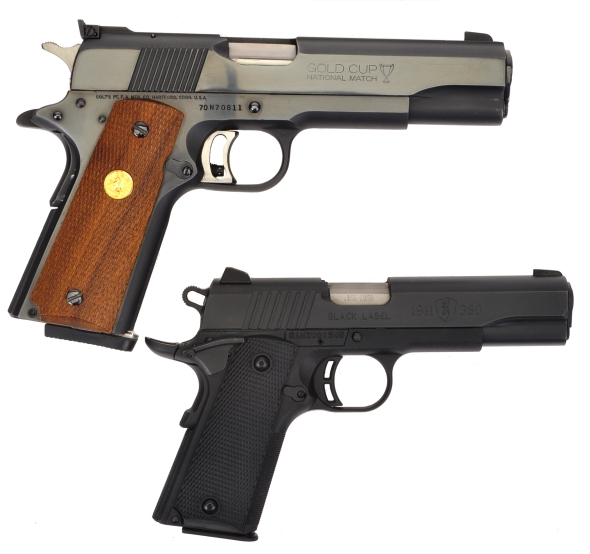
The Black Label 1911-380 is not one of those ill mannered, oddly balanced, stubby pocket pistols that have permeated the market. At approximately 85% scale of a full size 1911, there is enough grip length to accept stabilizing fingers, the external controls are properly placed to retain a 1911 feel and both slide stop and thumb safety are extended to permit operation without surrendering a shooting grip. The grip safety has a raised pad to assure compression and reliable release. Empty weight is just over 16 ounces, slide width is a narrow 0.785″ and grip width is 1.065″.
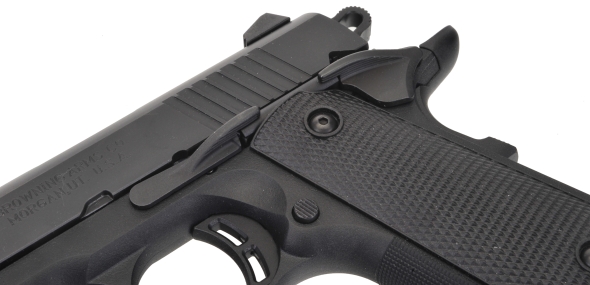
To a person familiar with the full size 1911, the 1911-380 will feel familiar. For a person who spends time gaining proficiency with the Black Label 1911-380, a full size 1911 will feel familiar. Fingers do tend to wrap around the Black Label’s slightly smaller grip a bit more and the knuckle of the trigger ends up positioned a bit farther forward than would be the case with a full size 1911. Still, the Black Label feels comfortable in the hand and the sights settle quickly and steadily on a target.
While appearances are very similar, the Browning centerfire 1911-380 and rimfire 1911-22 are quite different. They share a common 17.5º grip angle and, like approximately half of the 1911-22 models, the 1911-380 has a polymer frame. Unlike the 1911-22, the 380 version has a carbon steel slide as a Newtonian necessity; the 380 Auto’s increased energy requires greater reciprocating mass to assure durability and cycling reliability. The rim fire version’s slide is made of lightweight aircraft aluminum.

Where the 1911-22 is a straight blow back design, the 380 Auto version is a linkless, tilting barrel, locked breech design; appropriate for the more powerful centerfire cartridge. The 380 Auto version has a camming barrel lug versus the single locating hole present on the 22 rimfire version as illustrated below. The 380 Auto version has a one piece barrel rather than a pinned two piece barrel.

The 1911-380 does not have the radial lug slide/barrel lock up of a standard 1911 type pistol, but rather a a single locking lug that is integral to its barrel and so prevalent in modern autoloader designs. The lug pokes up through the pistol’s ejection port and locks up against the slide in battery. It releases when the pistol is discharged and the rearward moving slide drives the chamber end of the barrel downward, unlocking the action.
The 380 Auto in a defensive role
The 9mm Browning Short, or 380 Auto, or 380 ACP, 9mm Kurtz, or 9x17mm is always a subject of lively discussion, mostly born by a lack of understanding of its origins and intent. The 380 Auto was jointly developed by John Browning and J.W. Thomas of the United Metallic Cartridge Company, circa 1907 – 1908. The round was first chambered in the Colt Model 1908 and the F.N. Model 1910. The Colt was produced as a 1903 Model variation in 1908 and production for the FN Model 1910 began in 1912. At the time of its introduction, the 380 Auto round was considered as a step closer to other big bore autoloaders, advancing beyond the .25 and .32 caliber cartridges.
Neither the Colt nor the F.N. were intended to be last resort pocket pistol designs, but rather compact primary weapons. The FN Model 1910 was adopted for service by Belgium, Dutch, French, Syrian, Australian, Finland, Netherlands, Canada, and various African and South American governments for police and military applications. The last government contract was in 1974 when the Canadian government purchased Model 1910 pistols for senior officers stationed in Europe 1) 2).
Performance wise, chambered even in compact firearms, the 380 Auto vastly outperforms the 22 rimfire, 25 Auto, 32 Auto, and snub nose 38 Special as supported by field shooting reports 3). The extra length of the Browning Black Label 1911-380 barrel quantifiably advances the power of the 380 Auto well beyond that of a short barrel pistol.
S&W Body Guard 2.75″ barrel Vs. Browning 1911 380 4.25″ barrel
Three types of factory 380 auto ammo were used to compared short barrel – long barrel performance: Hornady Critical Defense 90 Grain FTX, PMC Bronze 90 Grain FMJ and Remington Golden Saber 102 Grain HPJ. Shot from 10′ into a Clear Ballistics gel blocks, the Browning Black Label 1911-380 showed a major improvement over the short barrel pistol in both penetration and expansion.
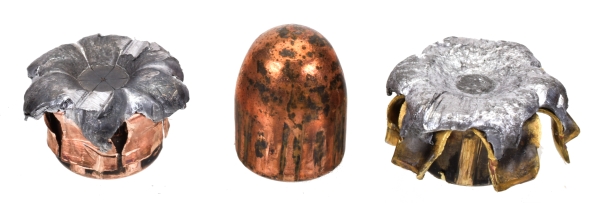
| Ammo | Bullet Weight |
MV FPS | Penetration | Expansion | |||
| S&W | Browning | S&W | Browning | S&W | Browning | ||
| Hornady FTX | 90 | 993 | 1080 | 4.2″ | 9.5″ | 0.502″ | 0.536″ |
| PMC Bronze | 90 | 867 | 1008 | 8.0″ | 18.0″ | 0.353″ | 0.355″ |
| Remington Golden Saber | 102 | 802 | 972 | 5.0″ | 9.0″ | 0.471″ | 0.643″ |
For fans of penetrating rounds, the PMC FMJ bullet blew right through the first 16″ gel block and was recovered from the second. Both the Hornady and Remington rounds nearly doubled in penetration, when fired from the Black Label’s 4.25″ barrel, which is notable as greater expansion often diminishes penetration. For me, the improvements realized with the Browning established the combination as a solid performer with a definite benefit for home defense; stopping power and adequate penetration without over penetration.
Overall
| Browning Black Label 1911-380 | |
| Manufactured | Morgan, Utah |
| Item Number | 051904492 |
| Type Action | Tilting Barrel, Locked Breech |
| Caliber | 380 Automatic |
| Capacity | 8+1 |
| Slide Material | Alloy Steel |
| Frame Material | Poly Composite |
| Trigger Pull | 5.8 Lbs. |
| Barrel Length | 4.25″ |
| Rifling | 1:16″ |
| Sights | Combat – Drift Adjustable |
| Sight Radius | 5 3/8″ |
| Type Safety | Thumb & Grip |
| Overall Length | 7.50″ |
| Overall Height | 4.50″ |
| Grip Thickness | 1.065″ |
| Weight | 16.2 Ounces |
| MSRP | $669.99 |
This Black Label 1911-380 saw a good deal of ammo… it is not the type of firearm that is easy to put up. The sights are clean and crisp against a target, recoil is moderate, as is report. Accuracy is very good, cloverleaf at 7 yards, inside 2 1/2″ at 25 yards with Hornady and Remington ammo, inside 3″ with PMC FMJ ammo. The little Browning has a very natural point and the longer barrel gives it a steady neutral to slightly nose heavy balance depending on how may rounds remain in its magazine.
No problems were encountered with ammo. Full metal jacket, different hollow point ogive tapers and nose cavities all fed without a hitch. The pistol fed and cycled reliably, the slide always remained open on an empty magazine. The magazine was quick to change and easy to load. Disassembly for cleaning was a snap; mag out, hammer back, slide to the disassembly notch, and the slide stop pushed out. Then the upper assembly slides forward and off. It comes apart like a 1911 including recoil spring, barrel and barrel bushing.
The grips are removable and interchangeable with grips from the Browning 1911-22. There are a number of accessory sets available on the Browning site. The rear sight is dovetail mounted and removable, the front is a pop in – tab lock arrangement which suggests that at some point in the future, Browning could offer owner installable sight sets of various types. The sights work well as received, but some folks like a Tritium or FireSight option. Perhaps there is a version like the Black Label Regal 1911-22 in the 1911-380’s future with an aluminum alloy frame and dovetail mounted front sight?
The only area I encountered that could be improved upon is the trigger; a noticeable amount of creep, somewhat heavy pull and a bit of overtravel. As every 1911-22 I’ve handled previously has had a clean trigger with a crisp let off, relatively light pull, and minimal overtravel, this particular pistol might be the issue and not something more typical of the 1911-380. I could see the Black Label 1911-380 replacing my rimfire trail gun and I could see it replacing a compact 9mm house gun. I could see buying it just for recreational target shooting and having fun. A very nice 380 Auto.
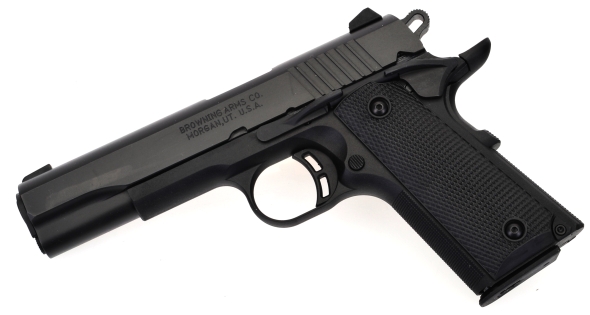
1) Colt, and American Legend – R.L. Wilson
2) FN Pistols – Side Arms That Shaped History – Anthony Vanderlinden
3) Stopping Power. A Practical Analysis of the Latest Handgun Ammunition – Marshall and Sanow

Email Notification